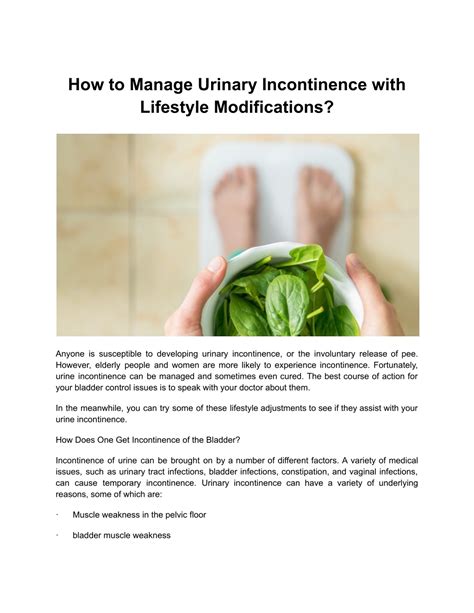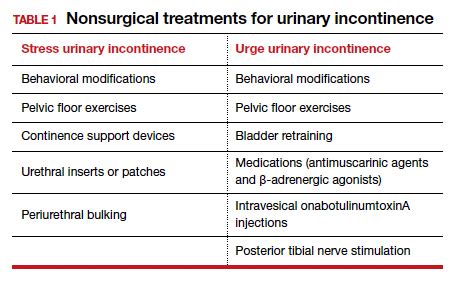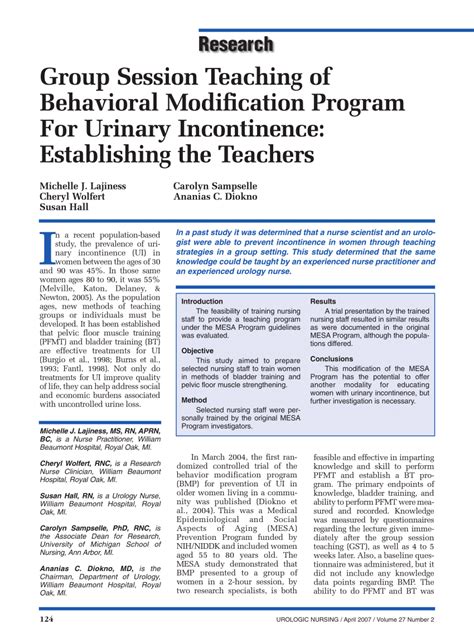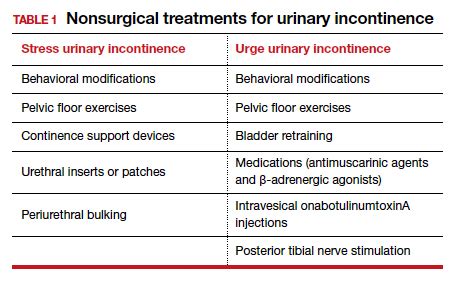Intro
Discover 5 effective ways to manage urinary incontinence, including pelvic exercises, bladder training, and lifestyle changes, to regain control and confidence, alleviating symptoms of overactive bladder and stress incontinence.
Urinary incontinence is a common health issue that affects millions of people worldwide, causing significant distress and impacting daily life. It is characterized by the involuntary leakage of urine, which can be embarrassing and debilitating. Despite its prevalence, urinary incontinence remains a taboo topic, with many individuals hesitating to seek help due to feelings of shame or embarrassment. However, it is essential to recognize that urinary incontinence is a treatable condition, and seeking medical attention is the first step towards managing its symptoms.
The impact of urinary incontinence on daily life cannot be overstated. It can lead to social isolation, decreased self-esteem, and reduced quality of life. Moreover, urinary incontinence can also have economic implications, with individuals spending significant amounts on absorbent products, laundry, and healthcare services. Fortunately, there are various ways to manage urinary incontinence, ranging from lifestyle modifications to medical interventions. By understanding the causes and symptoms of urinary incontinence, individuals can take the first step towards regaining control over their bladder and improving their overall well-being.
Urinary incontinence can be caused by a range of factors, including weak pelvic muscles, neurological disorders, and certain medical conditions. In women, childbirth and menopause are common contributing factors, while in men, an enlarged prostate or prostate surgery can increase the risk of developing urinary incontinence. Regardless of the underlying cause, managing urinary incontinence requires a comprehensive approach that incorporates lifestyle changes, behavioral modifications, and medical treatments. By adopting a proactive approach, individuals can reduce the frequency and severity of incontinence episodes, improving their overall quality of life.
Understanding Urinary Incontinence

Types of Urinary Incontinence
The different types of urinary incontinence require distinct management approaches. For instance, stress incontinence can be managed through pelvic floor exercises, while urge incontinence may require behavioral modifications, such as bladder training and dietary changes. Mixed incontinence, being a combination of both, necessitates a comprehensive approach that incorporates lifestyle changes, medical treatments, and behavioral modifications. By understanding the specific type of urinary incontinence, individuals can develop an effective management plan that addresses their unique needs and circumstances.Lifestyle Modifications for Urinary Incontinence

Pelvic Floor Exercises
Pelvic floor exercises are a simple yet effective way to manage urinary incontinence. These exercises involve contracting and releasing the pelvic muscles, which can be done discreetly at any time. To perform pelvic floor exercises, individuals should: * Identify the pelvic muscles by stopping the flow of urine mid-stream * Contract the pelvic muscles for 5-10 seconds * Release the muscles for 5-10 seconds * Repeat the exercise 10-15 times, 3-4 times a day By incorporating pelvic floor exercises into their daily routine, individuals can strengthen their pelvic muscles, improving bladder control and reducing the risk of incontinence.Medical Treatments for Urinary Incontinence

Medications for Urinary Incontinence
Medications can be an effective way to manage urinary incontinence, particularly urge incontinence. Anticholinergics, such as oxybutynin and tolterodine, work by relaxing the bladder muscle, reducing the urgency and frequency of incontinence episodes. Beta-3 adrenergic agonists, such as mirabegron, help to relax the bladder muscle and increase bladder capacity, reducing the risk of leakage. However, medications should be used under the guidance of a healthcare professional, as they can have side effects and interact with other medications.Behavioral Modifications for Urinary Incontinence

Bladder Training
Bladder training is a simple yet effective way to manage urinary incontinence. This involves: * Keeping a bladder diary to track fluid intake, urination, and incontinence episodes * Gradually increasing the time between trips to the bathroom * Avoiding trigger foods and drinks, such as caffeine and citrus fruits * Practicing relaxation techniques, such as deep breathing and meditation, to reduce stress and anxiety By incorporating bladder training into their daily routine, individuals can improve bladder control, reduce the frequency and severity of incontinence episodes, and enhance their overall quality of life.Alternative Therapies for Urinary Incontinence

Acupuncture for Urinary Incontinence
Acupuncture is a traditional Chinese medicine technique that involves the insertion of fine needles into specific points on the body. This can help stimulate the bladder, improve bladder control, and reduce the frequency and severity of incontinence episodes. While the exact mechanism of acupuncture is not fully understood, it is believed to work by: * Stimulating the release of neurotransmitters, such as dopamine and serotonin, which help regulate bladder function * Increasing blood flow to the bladder and pelvic area, helping to improve bladder health * Reducing stress and anxiety, which can contribute to urinary incontinence By incorporating acupuncture into their management plan, individuals can experience significant improvements in bladder control and overall quality of life.What are the most common causes of urinary incontinence?
+Urinary incontinence can be caused by a range of factors, including weak pelvic muscles, neurological disorders, and certain medical conditions. In women, childbirth and menopause are common contributing factors, while in men, an enlarged prostate or prostate surgery can increase the risk of developing urinary incontinence.
How can I manage urinary incontinence?
+Managing urinary incontinence requires a comprehensive approach that incorporates lifestyle changes, behavioral modifications, and medical treatments. Simple changes, such as maintaining a healthy weight, avoiding constipation, and managing fluid intake, can significantly reduce the frequency and severity of incontinence episodes.
What are the benefits of pelvic floor exercises?
+Pelvic floor exercises, also known as Kegel exercises, can help strengthen the pelvic muscles, improving bladder control and reducing the risk of incontinence. Regular practice can also enhance overall bladder health, reducing the frequency and severity of incontinence episodes.
Can alternative therapies help manage urinary incontinence?
+Yes, alternative therapies, such as acupuncture and physical therapy, can help manage urinary incontinence. These therapies can help stimulate the bladder, improve bladder control, and reduce the frequency and severity of incontinence episodes.
How can I reduce the risk of urinary incontinence?
+Reducing the risk of urinary incontinence involves maintaining a healthy lifestyle, including a balanced diet, regular exercise, and stress management. Avoiding constipation, managing fluid intake, and quitting smoking can also help reduce the risk of developing urinary incontinence.
In conclusion, managing urinary incontinence requires a comprehensive approach that incorporates lifestyle changes, behavioral modifications, and medical treatments. By understanding the causes and symptoms of urinary incontinence, individuals can develop a personalized management plan that addresses their unique needs and circumstances. Whether through pelvic floor exercises, bladder training, or alternative therapies, individuals can take control of their bladder health and improve their overall quality of life. We invite you to share your experiences and tips for managing urinary incontinence, and to explore the various resources and support groups available to help you navigate this common yet treatable condition.
